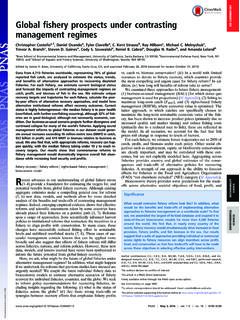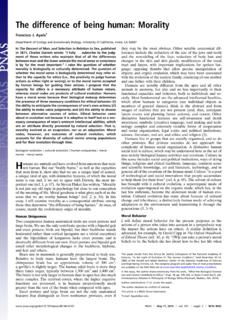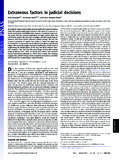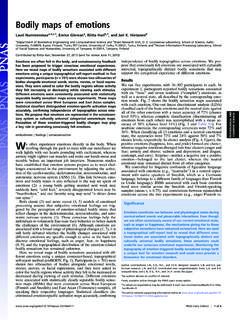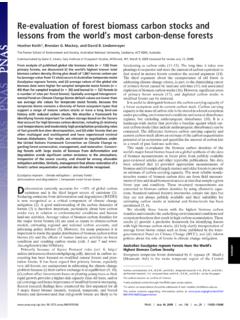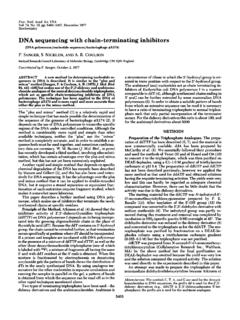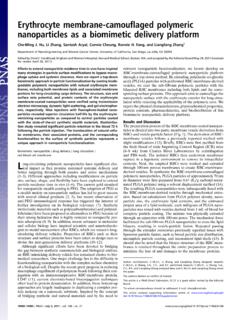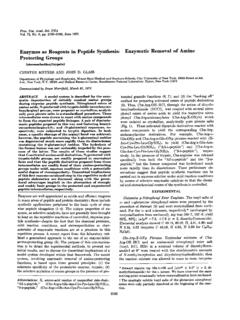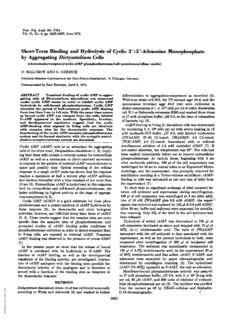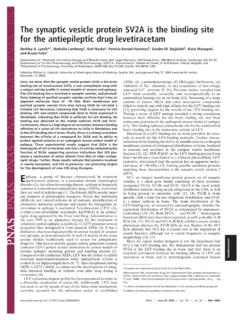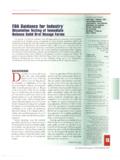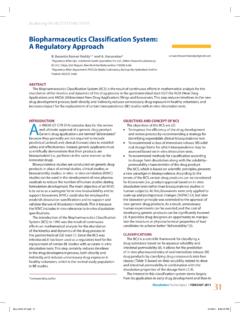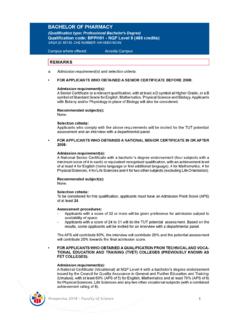Transcription of Charge-mediated influence of the antibody variable domain ...
1 Charge-mediated influence of the antibody variabledomain on FcRn-dependent pharmacokineticsAngela Schocha, Hubert Kettenbergerb, Olaf Mundiglc, Gerhard Winterd, Julia Engertd, Julia Heinricha,and Thomas Emricha,1aLarge Molecule Bioanalytical Research and Development, Pharmaceutical Sciences,bLarge Molecule Research Biochemical and Analytical Research, LargeMolecule Research, andcLarge Molecule Research Discovery, Large Molecule Research, Roche Pharmaceutical Research and Early Development, RocheInnovation Center Penzberg, 82377 Penzberg, Germany; anddInstitute of Pharmaceutical Technology and Biopharmaceutics, Ludwig MaximiliansUniversity, 81377 Munich, GermanyEdited by Jeffrey V. Ravetch, The Rockefeller University, New York, NY, and approved April 3, 2015 (received for review May 20, 2014)Here, we investigated the influence of the variable fragment (Fv)of IgG antibodies on the binding to the neonatal Fc receptor (FcRn)as well as on FcRn-dependent pharmacokinetics (PK).
2 FcRn plays akey role in IgG homeostasis, and specific manipulation in thecrystallizable fragment (Fc) is known to affect FcRn-dependent the influence of the antigen-binding fragment (Fab) onFcRn interactions has been reported, the underlying mechanism ishitherto only poorly understood. Therefore, we analyzed the twoIgG1 antibodies, briakinumab and ustekinumab, that have similarFc parts but different terminal half-lives in human and systemat-ically engineered variants of them with cross-over exchanges andvaried charge distribution. Using FcRn affinity chromatography,molecular dynamics simulation, and in vivo PK studies in humanFcRn transgenic mice, we provide evidence that the charge distri-bution on the Fv domain is involved in excessive FcRn binding.
3 Thisexcessive binding prevents efficient FcRn IgG dissociation at physi-ological pH, thereby reducing FcRn-dependent terminal , we observed a linear correlation between FcRn columnretention times of the antibody variants and the terminal half-livesin vivo. Taken together, our study contributes to a better under-standing of the FcRn IgG interaction, and it could also provide pro-found potential in FcRn-dependent antibody engineering of thevariable Fab |pharmacokinetics| antibody |charge|engine eringHuman IgGs contain two antigen-binding (Fab) regions thatconvey specificity for the target antigen and a constant (Fc)region that is responsible for interactions with Fc receptors (1, 2).Human IgGs of subclasses 1, 2, and 4 have an average serum half-life of 21 days (d), which is longer than that of any other knownserum protein (3).
4 This long half-life is predominantly mediated bythe interaction with the neonatal Fc receptor (FcRn) (4, 5) and isone of the reasons why IgGs or Fc-containing fusion proteins arewidely used as therapeutic is a membrane-associated receptor involved in both IgGand albumin homeostasis, in maternal IgG transport across theplacenta, and in antigen IgG immune complex phagocytosis (6 8). Human FcRn is a heterodimer consisting of the glycosylatedclass I major histocompatibility complex-like protein ( -FcRn)and a 2microglobulin ( 2m) subunit (9). FcRn binds to a site inthe CH2-CH3 region of the Fc region (10 13), and two FcRnmolecules can bind to the Fc region simultaneously (14, 15). Theaffinity between FcRn and Fc is strongly pH dependent, showingnanomolar affinity at endosomal pH of 5 6 and negligiblebinding at a physiological pH of (12, 16, 17).
5 The underlyingmechanism conveying long half-life to IgGs can be explained bythree fundamental steps. First, IgGs are subject to unspecificpinocytosis by various cell types (18, 19). Second, IgGs encounterand bind FcRn in the acidic endosome at a pH of 5 6, therebyprotecting IgGs from lysosomal degradation (10, 17, 20). Finally,IgGs are released in the extracellular space at physiological pHof (4). This strict, pH-dependent bind-and-release mecha-nism is critical for IgG recycling, and any deviation of the bindingcharacteristics at different pHs may strongly influence circulationhalf-lives of IgGs (21).In addition to the specific interaction of the Fc region withFcRn, the Fab regions have also been suggested to contributeto FcRn binding (22 24).
6 For example, Fab-mediated residualbinding at near physiological pH was correlated with the phar-macokinetic properties of a set of therapeutic antibodies, indi-cating that IgGs with excessive binding to FcRn at pH sufferfrom reduced terminal half-lives (23). Recently, Schlothauer et al.(24) have described a novel pH gradient FcRn affinity chroma-tography method that closely mimics physiological conditionsfor the dissociation between FcRn and IgGs. Furthermore, theyshowed that IgGs with identical Fc regions differ in their dis-sociation from FcRn, thereby indicating the influence of the Fabregion on FcRn binding. However, the underlying mechanismhow the distal Fab region influences FcRn binding is hithertoonly poorly systematically investigate the influencing factors of the Fabregion to FcRn-mediated IgG homeostasis, we used the antibodypair briakinumab (Ozespa) and ustekinumab (Stelara) as amodel system.
7 Both briakinumab and ustekinumab are fullyhuman monoclonal IgG1 antibodies that specifically bind to thehuman p40-subunit of interleukin 12 and interleukin 23 (25) andnot to the corresponding mouse interleukin 12 and interleukin23. Both antibodies have nearly identical constant IgG1 domains,with minor differences in several allotype-specific amino acids inthis region (Fig. S1). However, these different amino acids areoutside of the cognate FcRn-binding regions and thereforeare considered to play no significant role in FcRn-dependentSignificanceTherapeutic antibodies of the immunoglobulin G (IgG) isotypeshow a pharmacokinetic (PK) profile that is strongly mediatedby the interaction with the neonatal Fc receptor (FcRn).
8 There-fore, modulating the FcRn IgG interaction allows altering PKcharacteristics of therapeutic antibodies. So far, engineeringthe crystallizable fragment (Fc) is known to affect PK, and, al-though the influence of the antigen binding fragment (Fab) onFcRn interactions has been reported, the underlying mecha-nism remains unknown. Here, we demonstrate that the chargedistribution in the distal variable fragment (Fv) of IgGs is in-volved in excessive binding to the FcRn, thereby reducing FcRn-dependent terminal half-lives in vivo. These findings contributeto a better understanding of the FcRn IgG contributions: , , , , , and designed research; , ,and performed research; and analyzed data; and , , , , wrote the authors declare no conflict of article is a PNAS Direct available online through the PNAS open access whom correspondence should be addressed.
9 Email: article contains supporting information online |May 12, 2015|vol. 112|no. 19|5997 6002 APPLIED BIOLOGICALSCIENCES pharmacokinetics (PK) (10). Briakinumab is an IgG1 antibodywith variable heavy and light chain domains of the VH3 and V 1germ-line families. Ustekinumab is an IgG1 antibody with var-iable heavy and light chain domains of the VH5 and V 1D germ-line families. Interestingly, ustekinumab has a median terminalhalf-life of 22 d (26) whereas briakinumab has a terminal half-lifeof only 8 9 d (25, 27, 28). Therefore, we used briakinumab andustekinumab as our model system to elucidate the role of the Fabregion on FcRn-dependent , we report that the charge distribution in the variablefragment (Fv) domain is involved in excessive FcRn binding,thereby reducing FcRn-dependent terminal half-lives.
10 To eluci-date which structural element of the Fab region and how the Fabregion influences FcRn binding, we engineered nine variants ofbriakinumab and ustekinumab. Furthermore, we analyzed all 11antibodies using a combination of in vitro FcRn affinity chro-matography, molecular dynamics (MD) simulation, subcellulartrafficking analysis by confocal microscopy, and in vivo PK studiesin human FcRn transgenic Distribution and pH-Dependent Net the pub-lished crystal structure of ustekinumab (29) and a homologymodel of briakinumab, we observed that briakinumab exhibits anunusual, nonuniform charge distribution at physiological pH Briakinumab shows a large positively charged region on theFv domain (Fig. 1A) that is absent in ustekinumab (Fig.)
